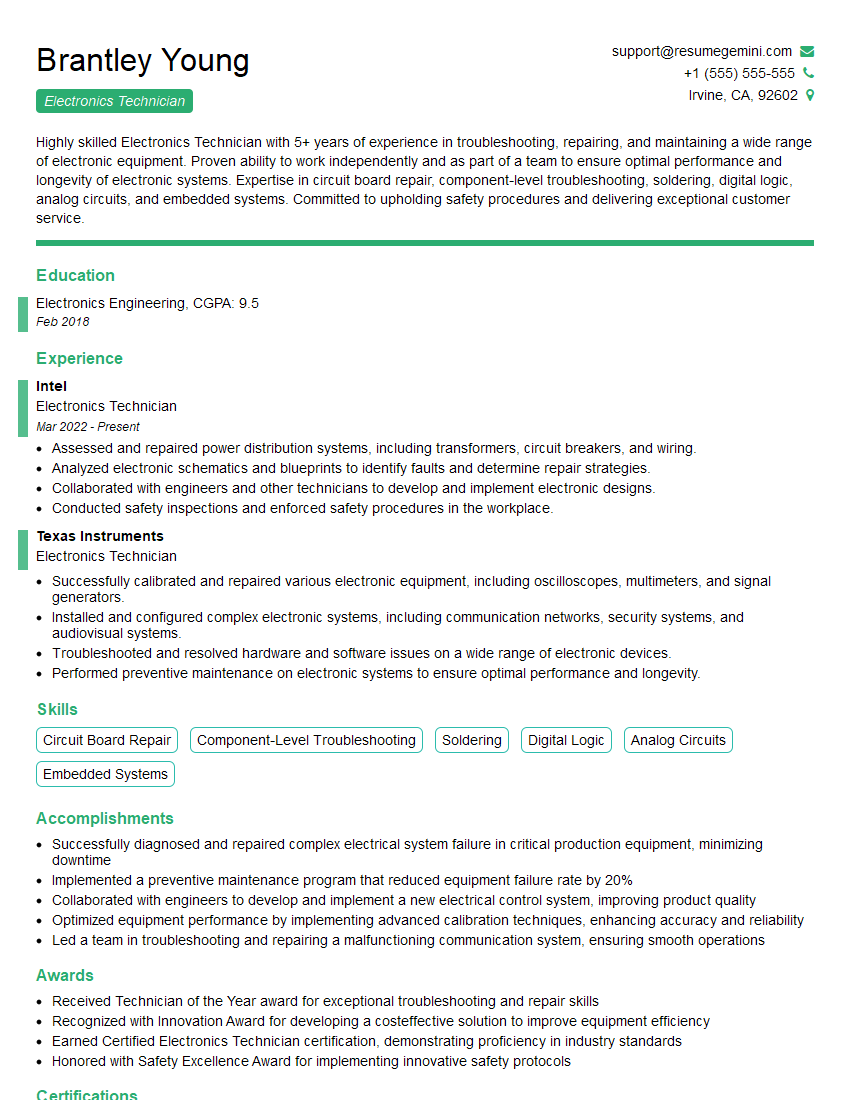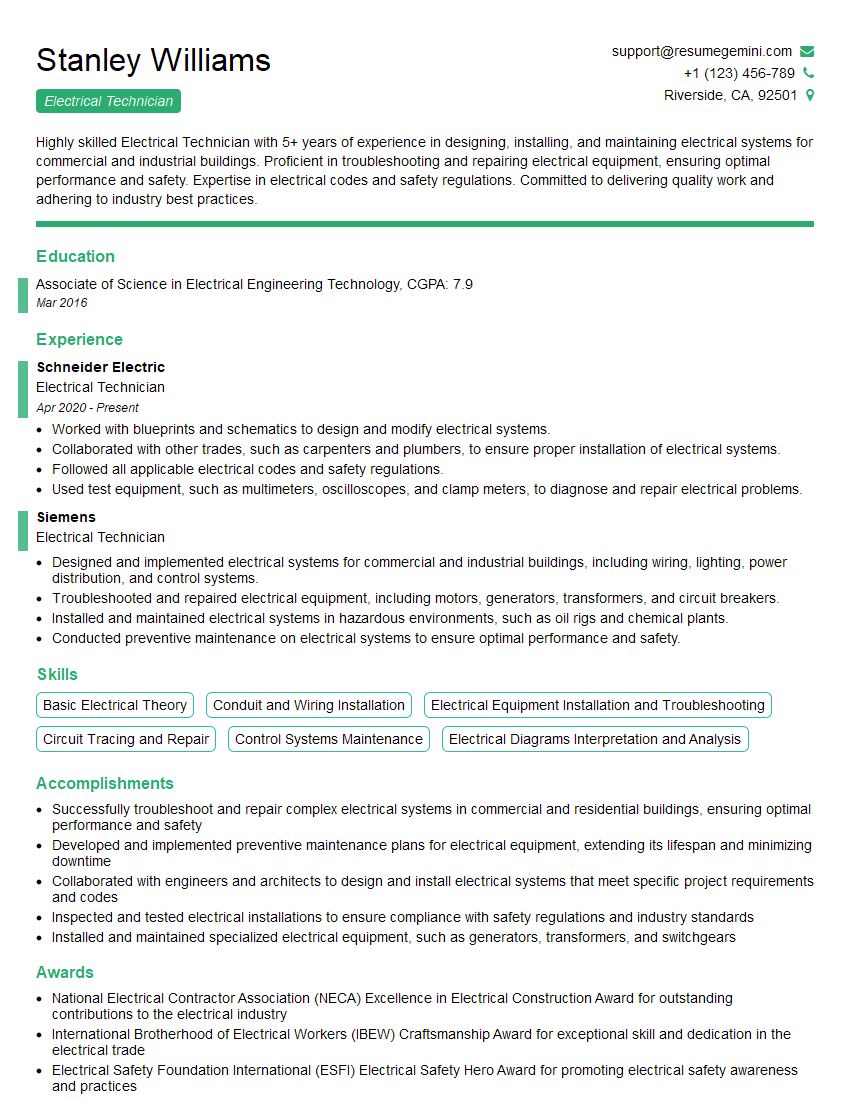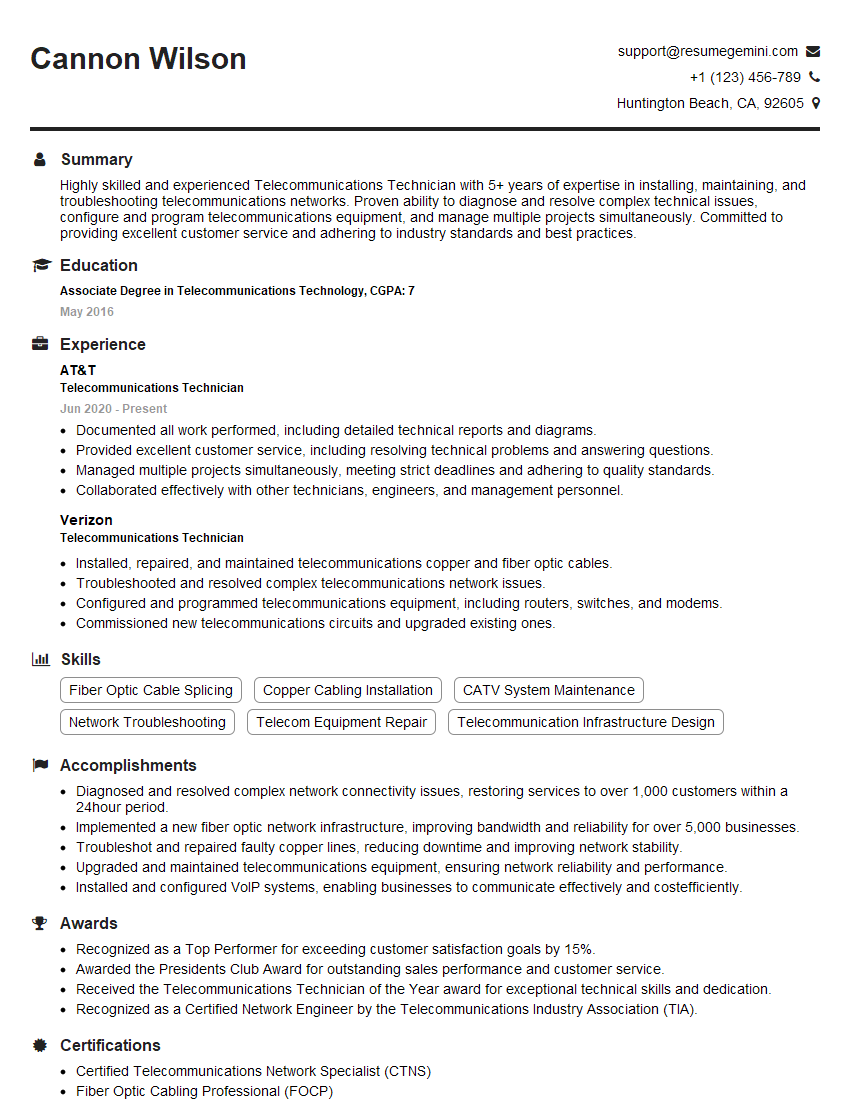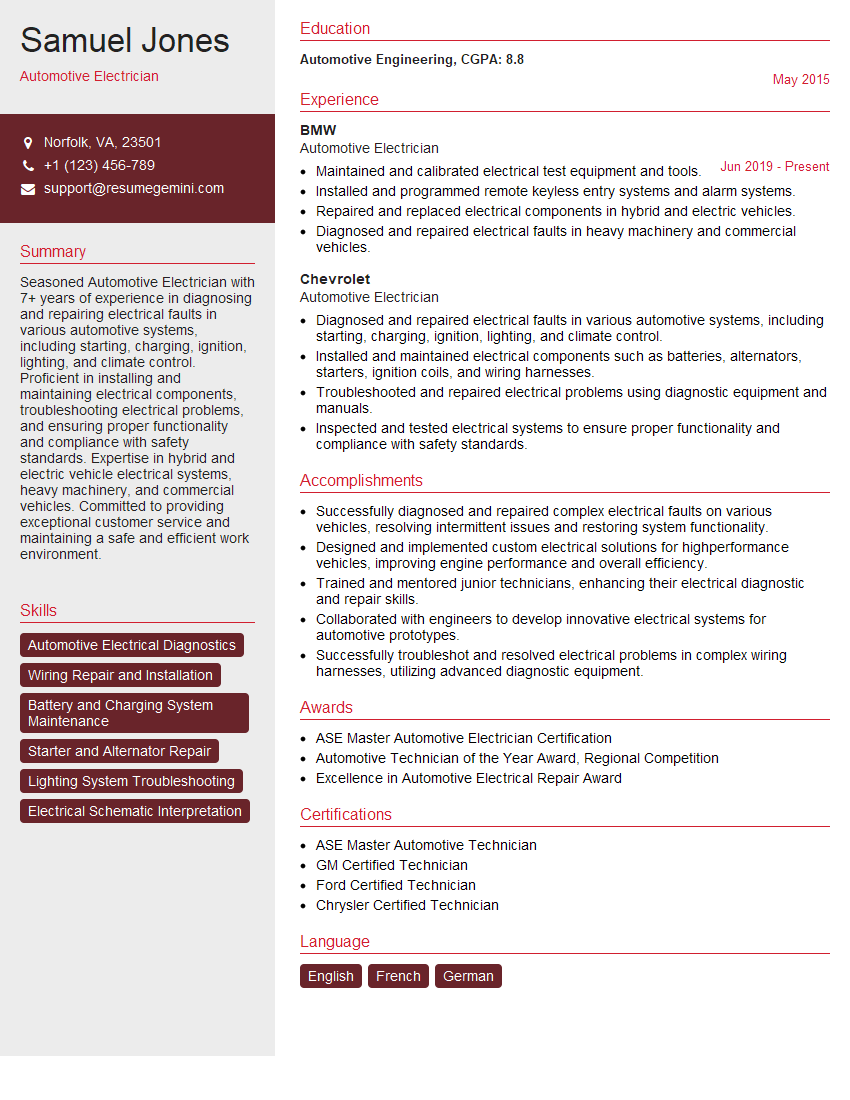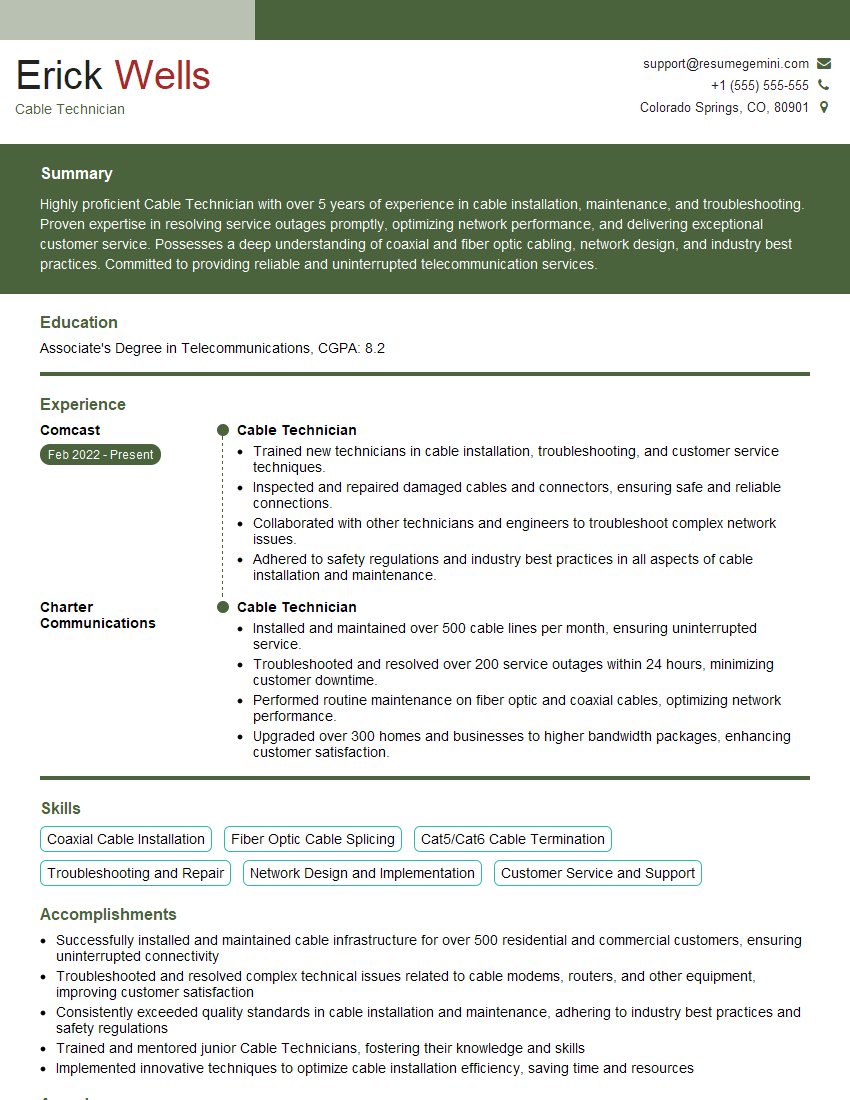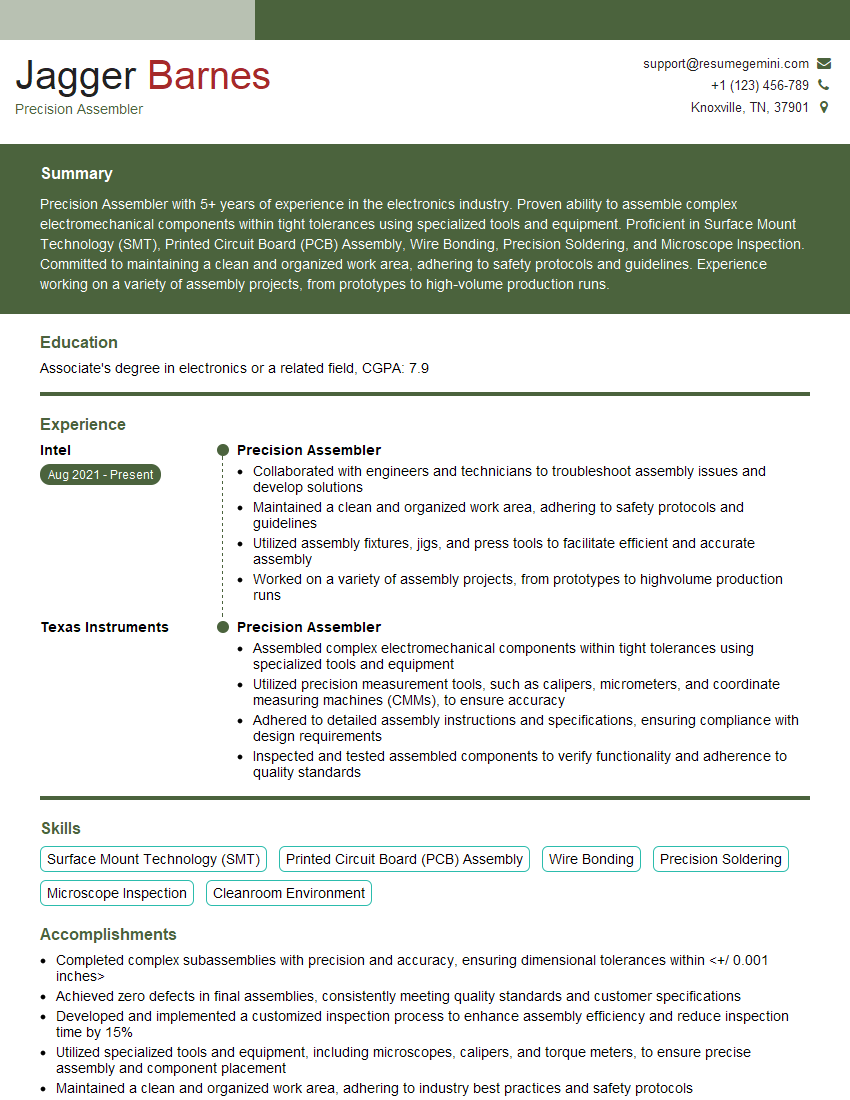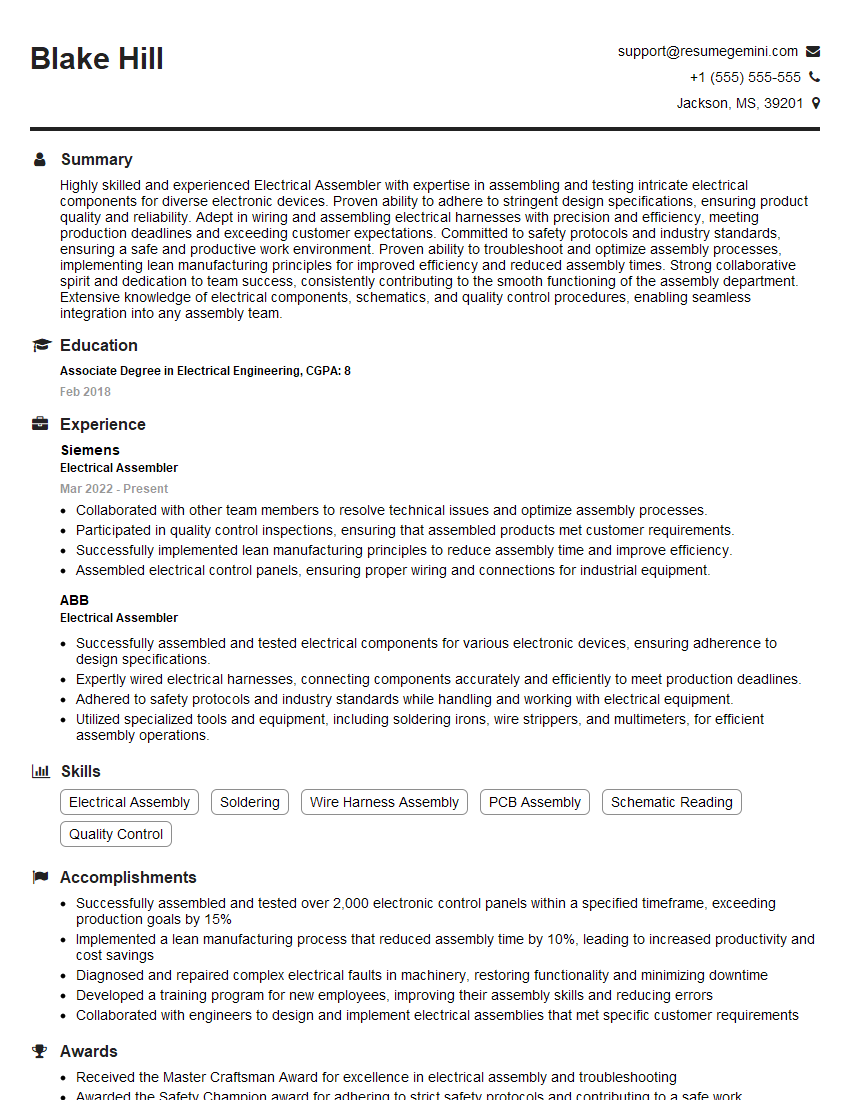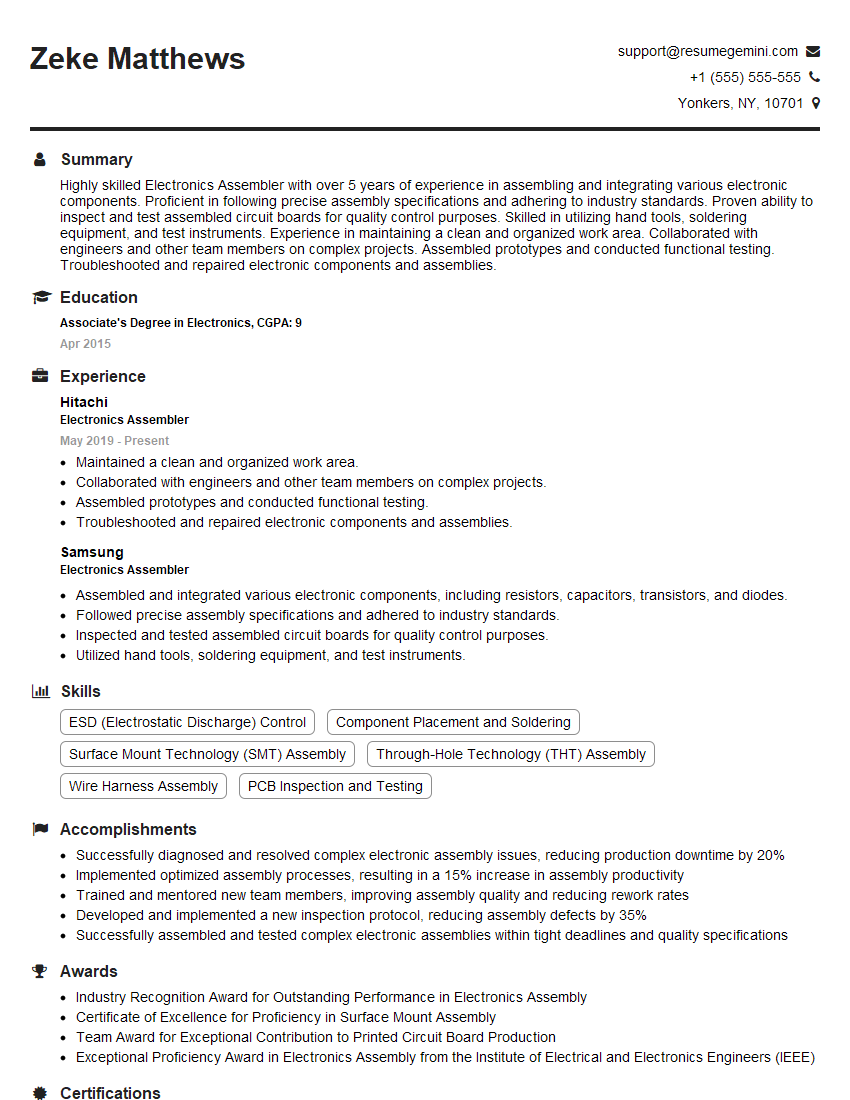Interviews are opportunities to demonstrate your expertise, and this guide is here to help you shine. Explore the essential Wire Stripping and Cutting interview questions that employers frequently ask, paired with strategies for crafting responses that set you apart from the competition.
Questions Asked in Wire Stripping and Cutting Interview
Q 1. What are the different types of wire strippers?
Wire strippers come in a variety of designs, each suited for different wire gauges and insulation types. The most common types include:
- Stripping tools with adjustable holes: These are versatile and allow you to strip various wire sizes by adjusting the hole size to match the wire diameter. Think of it like choosing the right wrench for a bolt – the right size ensures a clean strip.
- Automatic wire strippers: These tools often have a built-in mechanism that automatically adjusts to the wire diameter, making the process quick and efficient. This is great for high-volume jobs.
- Self-adjusting wire strippers: These are designed to automatically adjust to the wire size within a certain range, providing a quick and easy stripping method. Like an automatic gear shift in a car – it handles the adjustment for you.
- Wire strippers with different blades: Some strippers have multiple blades suited for specific wire insulation types (e.g., thin, thick, or delicate insulation) or even for different wire sizes. Having the right blade is like using the right tool for the job; a chisel for wood and a hammer for nails.
- Diagonal cutters with stripping features: Many diagonal cutters include a small stripping notch or holes near the cutting edge. These are convenient for quick stripping of smaller gauge wires.
Choosing the right stripper depends on your needs. For occasional use, a basic adjustable stripper works well, while professionals often opt for automatic or self-adjusting tools for speed and efficiency.
Q 2. Describe the proper technique for stripping various wire gauges.
Stripping wire correctly requires care and precision to prevent damage to the wire. The technique varies slightly depending on the wire gauge and the stripper type but the general principle is to avoid nicking the conductor.
- Identify the wire gauge: The gauge is usually printed on the wire’s jacket. This helps you select the appropriate stripper size or setting.
- Insert the wire: Carefully insert the wire into the correct hole or blade of the stripper. Make sure it’s fully seated to ensure a clean cut.
- Squeeze and rotate: Gently squeeze the handles of the stripper while rotating it slightly. This helps the blade cleanly slice through the insulation without damaging the conductor wire.
- Inspect the strip: After stripping, inspect the wire for any nicks or damage to the conductor. If damage is visible, discard the wire and start again.
Example: Stripping a 22 AWG stranded wire with an adjustable stripper would involve selecting the appropriate hole size for 22 AWG wire, carefully inserting the wire, and then squeezing and rotating to cut the insulation. You need a lighter touch with finer gauge wires to avoid damaging them.
For larger gauge wires, you may need more force and a larger stripper, always making sure you have a firm grip.
Q 3. What safety precautions should be taken when stripping and cutting wires?
Safety is paramount when working with wire. Always:
- Wear safety glasses: Flying debris can cause serious eye injuries.
- Use insulated tools: This prevents electric shock if working with energized wires.
- Disconnect power: Always disconnect power from any circuit before working on wires. If you cannot disconnect the power, take all necessary precautions such as using appropriate lockout/tagout procedures.
- Work in a well-lit area: This improves visibility and reduces the risk of accidents.
- Keep tools sharp: Dull tools increase the risk of slipping and causing injury.
- Dispose of waste safely: Dispose of cut wires and insulation properly to prevent environmental hazards.
Failing to take these precautions can lead to serious injuries such as cuts, electrical shock, and eye damage. Safety should always be your top priority.
Q 4. How do you identify different types of wire insulation?
Wire insulation comes in various colors and materials, each indicating different properties. Color coding is often used to identify voltage or circuit function, but this can vary.
- Visual inspection: Observe the color and texture of the insulation. Different materials have distinct appearances.
- Material identification: Some insulation is labeled, indicating its material (e.g., PVC, Teflon, etc.). This can be helpful for selecting the appropriate stripping tool.
- Experience: Experience helps you quickly identify common insulation types based on their appearance.
For instance, PVC insulation is often flexible and comes in various colors, while Teflon is typically more rigid and heat-resistant. Knowing the material helps you choose the right stripping method to avoid damaging the insulation or the conductor underneath.
Q 5. What are the consequences of improperly stripped wires?
Improperly stripped wires can have severe consequences, including:
- Poor electrical connections: If the conductor is nicked or damaged during stripping, it can lead to poor connections, resulting in intermittent operation or complete failure of the circuit. Imagine a loose screw holding things together – it won’t work as intended.
- Short circuits: Bare wires contacting each other or other conductive materials can cause short circuits, leading to overheating, fires, or equipment damage. This can be very dangerous.
- Electrical shock: Exposed conductors can pose a significant risk of electric shock, potentially leading to serious injury or death. Safety is paramount.
- Signal degradation: In signal transmission applications, improper stripping can reduce signal quality and lead to data loss or malfunction.
Always take your time and ensure the wire is stripped correctly to avoid these potentially hazardous situations.
Q 6. How do you handle stranded wire versus solid core wire?
Stranded and solid core wires require different stripping techniques.
- Solid core wire: This type of wire is easy to strip as it’s a single, solid conductor. Use a standard stripping tool, being careful to avoid damaging the conductor.
- Stranded wire: Stranded wire consists of multiple thin strands of wire bundled together. Stripping stranded wire requires care to prevent individual strands from breaking. Specialized tools or techniques are often used, such as a rotary stripper which provides a clean, consistent cut, minimizing strand damage.
The key difference lies in the delicacy required when stripping stranded wires. Too much force can fray or break the delicate strands, leading to an unreliable connection. For instance, in automotive wiring, where vibration is common, a correctly stripped stranded wire ensures a secure connection.
Q 7. Explain the importance of maintaining sharp wire cutters.
Maintaining sharp wire cutters is essential for safe and efficient work. Sharp cutters provide a clean, precise cut, minimizing the risk of wire damage, injuries, and accidental cuts.
- Clean cutters regularly: Remove debris and wire fragments from the cutting blades after each use.
- Sharpen cutters when necessary: Dull cutters require more force to cut, increasing the chance of damaging the wire or causing injury. Regular sharpening is important for precision and safety. Consider using a sharpening stone or professional sharpening service.
- Use the right cutters for the job: Avoid using cutters designed for other materials as this could damage the cutting edges.
Think of it like a surgeon’s scalpel – precision is key for a clean cut. Using dull cutters is like trying to cut with a butter knife – it’s messy and inefficient.
Q 8. What are the common causes of wire cutter damage?
Wire cutter damage is unfortunately common, and often stems from misuse or neglecting proper maintenance. Think of your wire cutters like a finely tuned instrument – if you mistreat it, it won’t perform optimally. The most frequent causes include:
- Using the wrong tool for the job: Attempting to cut excessively thick wire with a small cutter will lead to damage. It’s like trying to cut a thick rope with scissors – it’s just not designed for that!
- Cutting hardened or abrasive materials: Cutting wires encased in hard materials or those with abrasive coatings will dull the blades quickly. Imagine trying to cut through a steel cable with your regular cutters.
- Side-loading the cutters: Applying pressure unevenly, instead of squarely on the cutting edges, causes bending and damage. This is like trying to slice a carrot by twisting the knife instead of using a straight cut.
- Improper storage: Leaving cutters exposed to moisture or dirt will lead to rust and corrosion, affecting their cutting performance. Think of it as leaving a sharp knife in a wet sponge.
- Overuse without maintenance: Continuously using wire cutters without cleaning and sharpening them will dull the blades and lead to breakage. Similar to a car that needs regular oil changes – cutters need maintenance.
Q 9. How do you select the appropriate wire stripper for a specific job?
Selecting the right wire stripper depends on several factors. First, consider the wire gauge – the thickness of the wire. Different strippers are designed for specific gauge ranges. Next, look at the wire insulation material. Some insulations are tougher than others, requiring specialized strippers. Finally, think about the type of work. For delicate electronics, a precision stripper is needed, whereas for heavy-duty applications, a more robust tool would be suitable.
For example, when working with delicate electronics, I might choose a self-adjusting stripper with different sized stripping holes to avoid damaging the wire. If I’m working with larger automotive wiring, a heavier-duty, possibly manual, stripper with sharp, replaceable blades would be the best option.
Q 10. Describe your experience with different types of wire cutting tools.
My experience spans several types of wire cutting and stripping tools. I’ve worked extensively with:
- Diagonal Cutters (Dykes): Excellent for clean cuts on a wide range of wires, particularly smaller gauges. They’re my go-to for most tasks.
- Flush Cutters: Ideal when a clean, flush cut is required, leaving minimal wire sticking out. Perfect for trimming wires close to a component or terminal.
- Automatic Wire Strippers: Very efficient for high-volume jobs, particularly those involving consistent wire gauges and insulation types. These reduce the risk of human error.
- Crimping Tools: Used when making secure electrical connections after stripping wires, often used alongside the stripping tool.
- Ratcheting Cutters: These provide significant leverage, making it easier to cut thicker wires with less effort. A lifesaver for tougher jobs.
Each type has its strengths and weaknesses, and choosing the right tool depends on the specific job requirements. It’s about having the right tool for every situation.
Q 11. How do you deal with difficult-to-strip wires?
Dealing with difficult-to-strip wires requires patience and the right approach. Often, the problem is the type of insulation or the wire’s age and condition. Here’s a multi-step approach:
- Identify the issue: Is the insulation unusually hard, brittle, or gummy? Is the wire extremely fine or thick?
- Choose the right tool: Select a stripper designed for the specific wire gauge and insulation material. A high-quality tool will make a significant difference.
- Proper technique: Make sure you use the correct stripping technique for the tool selected, following manufacturer’s instructions. Applying too much pressure can damage the wire.
- Pre-scoring: For particularly tough insulation, try using a utility knife to carefully score the insulation before stripping. This creates a weaker point.
- Heat: In some cases, carefully applying gentle heat (e.g., using a heat gun) can soften the insulation, making it easier to strip. This must be done cautiously to avoid damaging the wire.
- Lubrication: Using a lubricant, such as WD-40 can also help the stripping process. However, always ensure compatibility with the wire’s material.
Sometimes, it’s better to cut your losses and use a fresh wire rather than risk damaging the conductor by forcing the stripping process.
Q 12. What techniques do you use to prevent wire damage during stripping?
Preventing wire damage during stripping relies on careful technique and tool selection. My key strategies include:
- Using the correct tool for the job: Avoid using tools that are too small or too large for the wire. The right tool will provide a clean and consistent strip.
- Sharp blades: Dull blades are a major cause of wire damage. Regularly check your cutters and strippers, and replace them promptly when they become dull.
- Proper grip: Use a firm but not excessive grip when operating the stripper or cutters to avoid bending or nicking the wire.
- Gentle pressure: Avoid using excessive force during stripping or cutting. Too much pressure can damage the wire’s insulation or conductor.
- Consistent cutting depth: Ensure you’re using the correctly sized notch or hole in the stripper to avoid removing too much or too little insulation.
- Avoid twisting the wire: Twisting the wire while stripping can cause it to break or fray.
By meticulously following these steps, I significantly reduce the risk of damage.
Q 13. What are the signs of a faulty wire stripper?
Signs of a faulty wire stripper are often subtle but can lead to significant problems. Look for:
- Jagged or uneven cuts: This indicates dull or damaged blades.
- Difficulty stripping the wire: The stripper may be too small for the wire, or its blades might be worn.
- Wire damage during stripping: Nicked or broken wires indicate a problem with the tool’s design, sharpness, or the operator’s technique.
- Loose or broken parts: If parts of the stripper are loose or broken, it needs immediate repair or replacement.
- Slipping jaws: Inability to maintain a grip on the wire indicates a problem with the tool’s mechanism.
If any of these issues arise, it’s important to stop using the tool immediately and assess its condition or replace it entirely.
Q 14. How do you ensure consistent wire length after cutting?
Ensuring consistent wire length after cutting is crucial for neatness and functionality, especially in projects where precision is paramount. My techniques include:
- Using a wire cutter with a built-in length gauge: Many modern cutters include a built-in mechanism for accurate and repeatable cuts.
- Using a measuring tool: A simple ruler or caliper helps measure the wire before cutting, ensuring precision.
- Cutting multiple wires at once: For batches of wires with the same required length, use a tool designed for cutting multiple wires simultaneously (if applicable).
- Practice and Precision: With experience, you develop a feel for accurately cutting the desired length with minimal waste.
- Using a cutting mat: A cutting mat provides a stable base and prevents the wire from moving while being cut.
For consistency across various jobs, I always start with clear measurements, and I regularly check and maintain my cutting tools.
Q 15. Describe your experience working with different wire materials (e.g., copper, aluminum).
My experience encompasses a wide range of wire materials, primarily copper and aluminum, but also including specialized alloys like stranded copper-clad aluminum (CCA). Copper is common due to its excellent conductivity, while aluminum is preferred in high-voltage applications for its lighter weight. However, aluminum requires specialized handling due to its tendency to work-harden and its oxide layer, which impacts conductivity if not properly addressed. I’ve worked with various gauges, from very fine wires in electronics to heavy-gauge wires in power distribution systems. Each material requires a tailored approach; for instance, stripping aluminum often necessitates different tools and techniques compared to copper to avoid damaging the wire. I’ve also handled specialized wires with insulation materials like Teflon, which require extra care during stripping to avoid damaging the insulation.
For example, when working on a high-voltage transmission line project, understanding the specific characteristics of aluminum wire—its softness and susceptibility to oxidation—was crucial for preventing failures. We used specialized tools and techniques to ensure a clean, consistent strip without nicking the wire.
Career Expert Tips:
- Ace those interviews! Prepare effectively by reviewing the Top 50 Most Common Interview Questions on ResumeGemini.
- Navigate your job search with confidence! Explore a wide range of Career Tips on ResumeGemini. Learn about common challenges and recommendations to overcome them.
- Craft the perfect resume! Master the Art of Resume Writing with ResumeGemini’s guide. Showcase your unique qualifications and achievements effectively.
- Don’t miss out on holiday savings! Build your dream resume with ResumeGemini’s ATS optimized templates.
Q 16. How do you manage wire waste?
Wire waste management is crucial for both cost-effectiveness and environmental responsibility. My approach involves several key strategies. First, precise measurement and cutting minimize excess material. I utilize tools that allow for accurate length adjustments and pre-cutting to reduce material waste. Secondly, I meticulously collect and segregate scrap wire by material type (copper, aluminum, etc.) for proper recycling. This ensures that valuable resources are recovered instead of being discarded. Thirdly, I employ techniques like pre-fabrication of wire harnesses wherever possible to control waste during assembly. This involves planning the layout and cutting lengths efficiently before beginning the assembly process. Finally, I regularly review my processes to identify areas for further improvement in waste reduction.
For instance, on a recent project, by implementing a new cutting system and improving pre-cutting planning, we reduced wire waste by approximately 15%, contributing to significant cost savings and a smaller environmental footprint.
Q 17. Explain the process of crimping wires.
Crimping is a crucial process for securely joining wires to terminals or connectors. It involves using a crimping tool to deform a connector’s barrel around the wire, creating a strong mechanical connection. The process is critical for ensuring electrical continuity and preventing connections from failing due to vibration or other stresses. The key steps involve selecting the correct crimping tool for the wire gauge and connector type, inserting the wire into the connector, and then properly applying the crimping tool to ensure a full and complete crimp. Incomplete crimps can lead to poor electrical conductivity or connection failure. Always visually inspect the crimp after completion to ensure that it has been properly formed and that there are no signs of damage to the wire or connector.
For example, when working with high-current applications, a properly crimped connection is essential to avoid overheating and potential fires. Using the wrong crimping tool or technique could lead to a poor connection, increasing resistance and causing the connection to overheat.
Q 18. How do you inspect stripped and cut wires for quality?
Quality inspection is critical to prevent potential electrical issues and ensure the reliability of the system. My inspection process involves several steps. First, I visually inspect the stripped wire for any nicks, cuts, or damage to the conductor. The insulation should be cleanly removed to the correct length, without any fraying or damage. Second, I check the wire’s length against the specified requirements. Any significant deviations are noted. Third, for crimped connections, I visually inspect the crimp for proper formation and look for signs of damage. I often use magnification tools for a detailed examination. Finally, for very critical applications, I perform continuity tests to verify electrical connections.
Imagine working on an aircraft’s wiring harness—a compromised connection could be disastrous. Meticulous inspection is vital to ensure the system’s integrity and the safety of those on board.
Q 19. What are the different types of wire connectors?
Wire connectors come in a wide variety of types, each suited for different applications and wire gauges. Some common types include:
- Butt connectors: Used to join two wires of similar gauge.
- Splice connectors: Designed to join wires of different gauges.
- Ring terminals: Used to connect wires to screw terminals.
- Quick disconnect connectors: Offer easy connection and disconnection.
- Heat shrink connectors: Provide a waterproof and insulated connection.
- Screw-type connectors: Used for secure and reliable connections.
The choice of connector depends on factors like the wire gauge, current carrying capacity, environmental conditions, and ease of use. For example, in a marine environment, a waterproof heat-shrink connector might be preferable to a standard butt connector to prevent corrosion.
Q 20. How do you troubleshoot issues related to wire stripping or cutting?
Troubleshooting issues in wire stripping or cutting often involves systematic investigation. If the wire is not stripping cleanly, I first check the sharpness of the stripping tool. A dull blade is a common culprit. I then consider the wire material and gauge—specialized tools are needed for certain materials. If a crimped connection is failing, the crimp itself is carefully examined for proper formation and signs of damage. Improper crimping technique is often the cause. I also inspect the connector for defects and check the wire gauge against the connector’s rating. For continuity issues, a multimeter is used to trace the circuit and identify broken wires or loose connections. Proper grounding and insulation are also checked.
For instance, if I encounter intermittent shorts in a circuit, I would systematically check all connections and insulation, using a multimeter to verify continuity and identify potential sources of the short circuit.
Q 21. What is the importance of proper wire preparation in electrical systems?
Proper wire preparation is absolutely fundamental to any electrical system. It directly impacts the system’s reliability, safety, and performance. Improperly stripped or cut wires can lead to poor connections, increased resistance, overheating, electrical fires, and even equipment failure. Clean, consistent stripping ensures proper contact between the wire and the connector, minimizing resistance and heat generation. Secure connections prevent loose wires, which can cause shorts or intermittent outages. In addition, correct insulation removal prevents short circuits and ensures electrical safety. Thorough preparation guarantees that the electrical system operates as designed and maintains its integrity over time.
Consider a building’s electrical wiring. Poorly prepared wires could lead to overloaded circuits, causing a fire hazard. In contrast, correctly prepared and connected wires guarantee a safe and reliable supply of electricity to the building.
Q 22. Describe your experience with automated wire stripping and cutting machines.
My experience with automated wire stripping and cutting machines spans over eight years, encompassing various models from leading manufacturers like Komax and Schleuniger. I’m proficient in programming and operating these machines for high-volume production runs, adjusting settings for different wire gauges, insulation types, and stripping lengths. I’ve also been involved in troubleshooting malfunctions, performing preventative maintenance, and calibrating the machines to ensure consistent accuracy. For example, I recently optimized the settings on a Komax Alpha machine to reduce waste by 15% during the production of a high-precision harness for automotive applications. This involved fine-tuning the blade pressure and feed rate to minimize wire damage while maintaining stripping consistency.
My expertise extends to understanding the strengths and limitations of different machine types. For instance, I know that while fully automated machines offer high speed and precision, semi-automated options are better suited for smaller production runs or applications requiring greater flexibility in wire handling. I’m comfortable working with both.
Q 23. How do you maintain a clean and organized work area when working with wires?
Maintaining a clean and organized workspace is paramount for efficient and safe wire handling. My approach involves several key strategies. First, I dedicate specific areas for different tasks: a dedicated space for cutting, stripping, and crimping, for instance. This prevents cross-contamination and makes it easy to find tools and materials. Second, I use clearly labelled containers to organize wires by gauge, color, and material. This significantly reduces the risk of mistakes. Third, I regularly clean my work area, removing wire scraps and debris, and wipe down surfaces to prevent short circuits or accidental entanglement. Think of it like a surgeon preparing an operating theatre – precision and cleanliness are essential. Finally, using wire organizers and cable trays helps keep wires neatly routed and prevents tangling.
Q 24. How would you handle a situation where a wire is damaged during stripping?
If a wire is damaged during stripping, my first step is to assess the extent of the damage. Minor nicks can often be safely ignored if they don’t compromise the integrity of the conductor or insulation. However, if the conductor is exposed or the insulation is severely compromised, the wire must be discarded. This is crucial for safety and reliable electrical connections. In such cases, I would retrieve a replacement wire from my inventory, ensuring it matches the specification of the damaged wire. I always double-check my work before proceeding.
For example, during the production of a control panel, I discovered a nicked wire that exposed a small section of the conductor. While initially tempted to try and repair it, I immediately discarded the wire and replaced it. This was important as compromising the wire’s integrity could have had serious consequences down the line, such as short circuits, equipment malfunction, or even fire hazards.
Q 25. What are the relevant safety regulations you follow when handling wires?
Safety is my top priority. I always follow relevant safety regulations, including those outlined by OSHA (Occupational Safety and Health Administration) and any company-specific guidelines. This includes wearing appropriate personal protective equipment (PPE) such as safety glasses, cut-resistant gloves, and anti-static wrist straps (especially when working with sensitive electronics). I ensure that all tools are in good working order and properly maintained. I’m meticulous about working in well-lit areas and keeping the workspace free from clutter to prevent tripping hazards. Furthermore, I always disconnect power sources before working on any live wires and use insulated tools to prevent electrical shocks. Regular safety training is critical to maintaining awareness and implementing safe practices.
Q 26. How do you identify different wire color codes?
Identifying wire color codes is a fundamental skill. Color codes vary depending on the application and industry standards. I have extensive experience interpreting various color-coding systems, including those used in automotive, industrial, and telecommunications applications. I consult relevant industry standards and schematics to interpret the meaning of specific color combinations. For example, in many North American applications, black often represents ground, red signifies positive, and white indicates neutral. However, there are many variations, so cross-referencing with documentation is key. Often, manufacturers provide detailed color-coding charts for their products.
Q 27. How do you ensure the correct polarity when working with wires?
Ensuring correct polarity is crucial to avoid damaging equipment or creating unsafe conditions. I always refer to schematics, wiring diagrams, and other documentation to verify the correct polarity before connecting wires. In AC systems, polarity isn’t as critical as in DC systems. In DC systems, I will always check for voltage using a multimeter before connecting. I use a multimeter to verify the voltage and polarity of each wire before connecting it to a circuit. This prevents accidental short circuits or damage to sensitive electronic components. It is always essential to confirm the polarity in the diagram matches the physical wires you are handling.
Q 28. Describe your experience with different wire insulation materials.
My experience encompasses a wide range of wire insulation materials, each with its unique properties and applications. I’m familiar with PVC (polyvinyl chloride), commonly used for its cost-effectiveness and durability in general-purpose applications; Teflon (PTFE), offering excellent heat resistance and chemical stability, making it suitable for high-temperature environments; and silicone rubber, known for its flexibility and high-temperature tolerance. I’ve also worked with various specialized materials like polyurethane and cross-linked polyethylene, each selected based on the specific requirements of the application and environmental conditions. Understanding the properties of these materials allows me to choose the right wire for the job, ensuring optimal performance and longevity.
Key Topics to Learn for Your Wire Stripping and Cutting Interview
- Wire Gauge and Selection: Understanding different wire gauges and selecting the appropriate tools and techniques for each.
- Stripping Techniques: Mastering various stripping methods (e.g., manual, automated, using different tools) and recognizing when to apply each.
- Cutting Techniques: Proficiency in various cutting techniques (e.g., flush cuts, angled cuts) and understanding their applications in different scenarios.
- Tool Selection and Maintenance: Identifying the right tools for the job (e.g., strippers, cutters, wire crimpers) and performing basic maintenance.
- Safety Procedures: Prioritizing safety by adhering to proper handling procedures, using personal protective equipment (PPE), and identifying potential hazards.
- Quality Control: Inspecting stripped and cut wires for quality, identifying defects, and understanding the implications of inconsistencies.
- Troubleshooting: Diagnosing and resolving common problems encountered during wire stripping and cutting, such as damaged wires or malfunctioning tools.
- Industry Standards and Regulations: Familiarity with relevant industry standards and safety regulations pertaining to wire handling and processing.
- Practical Applications: Understanding the applications of wire stripping and cutting in various industries (e.g., electronics manufacturing, automotive, telecommunications).
- Production Efficiency: Optimizing techniques for speed and accuracy while maintaining quality and safety.
Next Steps: Level Up Your Career
Mastering wire stripping and cutting is a valuable skill that opens doors to numerous opportunities in various industries. It demonstrates attention to detail, precision, and a commitment to quality – all highly sought-after traits by employers. To maximize your job prospects, focus on crafting a compelling and ATS-friendly resume that highlights these skills.
ResumeGemini can help you create a professional and impactful resume that gets noticed. Using ResumeGemini will ensure your skills and experience shine through. We provide examples of resumes tailored specifically to the Wire Stripping and Cutting field to help you get started. Invest in your future – build a resume that gets you the interview.
Explore more articles
Users Rating of Our Blogs
Share Your Experience
We value your feedback! Please rate our content and share your thoughts (optional).
What Readers Say About Our Blog
Hello,
We found issues with your domain’s email setup that may be sending your messages to spam or blocking them completely. InboxShield Mini shows you how to fix it in minutes — no tech skills required.
Scan your domain now for details: https://inboxshield-mini.com/
— Adam @ InboxShield Mini
Reply STOP to unsubscribe
Hi, are you owner of interviewgemini.com? What if I told you I could help you find extra time in your schedule, reconnect with leads you didn’t even realize you missed, and bring in more “I want to work with you” conversations, without increasing your ad spend or hiring a full-time employee?
All with a flexible, budget-friendly service that could easily pay for itself. Sounds good?
Would it be nice to jump on a quick 10-minute call so I can show you exactly how we make this work?
Best,
Hapei
Marketing Director
Hey, I know you’re the owner of interviewgemini.com. I’ll be quick.
Fundraising for your business is tough and time-consuming. We make it easier by guaranteeing two private investor meetings each month, for six months. No demos, no pitch events – just direct introductions to active investors matched to your startup.
If youR17;re raising, this could help you build real momentum. Want me to send more info?
Hi, I represent an SEO company that specialises in getting you AI citations and higher rankings on Google. I’d like to offer you a 100% free SEO audit for your website. Would you be interested?
Hi, I represent an SEO company that specialises in getting you AI citations and higher rankings on Google. I’d like to offer you a 100% free SEO audit for your website. Would you be interested?
good

